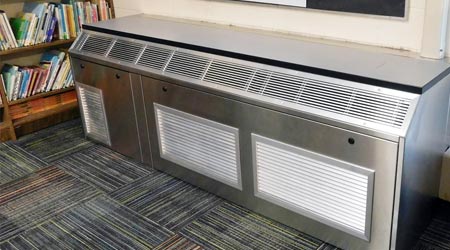« Back to Facilities Management News Home
« HVAC
VRF Combines with ERV to Boost IAQ

RevolutionAire Inc. a North American manufacturer of revolutionary indoor air quality (IAQ) equipment, introduces the Slimline Series, the HVAC industry’s first variable refrigerant flow (VRF) and energy recovery ventilation (ERV) technology combined in a unit ventilator system configuration. The Slimline is designed for new construction and unit ventilator retrofits of schools, hospitals, hotels and other commercial facilities.
The patented Slimline is the perfect drop-in HVAC retrofit solution for schools without air conditioning, without space to install ASHRAE 62.1-compliant outdoor air duct, or burdened with the high operating costs and insufficient IAQ of conventional two-pipe/four-pipe fan coil unit ventilators.
The VRF and onboard ERV enthalpy wheel or enthalpy core, combined with variable frequency-controlled electronically commutated (EC) motors offers up to significantly more efficiency and less operating sound than “old school” unit ventilators. Its superior sensible and latent load handling capacity far surpass minimum energy requirements of ASHRAE 90.1-2017
Besides pinpoint humidity and temperature control, the Slimline’s proprietary onboard microprocessor command center, along with onboard and room remote sensors, monitor and control for CO2, particulates and volatile organic compounds (VOC) for a healthies possible breathing environment. An optional onboard zero-ozone, ultraviolet germicidal irradiation (UVGI) system can disinfect return air biological contaminants, such as cold viruses, mold, bacteria and influenza, which can help school districts surpass federal incentive goals for student attendance and achievement tests. MERV 8 particulate media filters are standard; however a MERV 11 option is available with automatic airflow modifications activated by the command center’s static pressure control function.
The Slimline ranges from 1-1/2 to 4.5-tons, 600 to 1,800-CFMs and features a 32-inch-high, 20-inch-deep high quality stainless steel or powder-coated cabinet in either a 94-inch or 104-inch length. Its two models can replace 90-percent of the HVAC industry’s existing unit ventilator configurations and footprints without the need for wall/ floor aesthetic repairs after installation. Its flexible capacities accommodate most learning environments from conventional classroom sizes to large specialty rooms, such as science labs, art rooms and libraries.
While most unit ventilator tops are off-limits for books and supplies, the Slimline’s built-in, aesthetic 1-1/4-inch-thick laminate worktop feature can support books and supplies while also adding classroom display space. Laminates can be ordered in a variety of colors. The VRF system can adequately heat during ambient temperatures as low as -5°F. Extreme northerly locations can opt for a factory installed hot water coil as a supplemental heat source on sub-zero days.
Other Slimline Series features include:
- Available in stainless steel finish, or six standard powder coat colors in gray and beige tones. Custom colors are also available for precisely matching school colors or interior designs;
- Controller boasts eight universal input/outputs, six digital outputs, six analog outputs and the ability to be monitored or interfaced with any BACnet™ protocol building management system (BMS);
- Third-party tested operating noise at less than 45-dB at one meter off the floor and grille, which can qualify for LEED® noise criteria credits;
- Extruded aluminum grille design prevents pencils, pens and other slim objects from falling into the unit. A locking service access door eliminates tampering;
- Optional on-board refrigerant monitor immediately detects and warns of leaks;
- Can qualify for utility incentives, such as the seven-state Tennessee Valley Authority’s EnergyRight® Solutions program that offers up to $210/ton on HVAC upgrades that include VRF.
More From 12/19/2018 on FacilitiesNet












